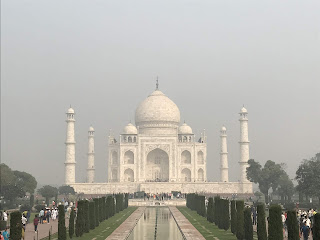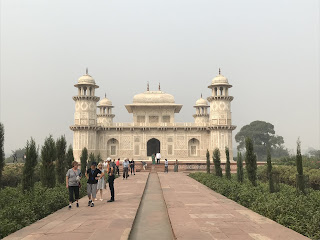The Taj Mahal, Agra Fort
The Taj Mahal, Agra Fort
Today, at the convened hour, my driver was waiting for me with his rickshaw to take me on my full tour of all things Agra. Before we started, I double-checked the itinerary and the price and everything, to make it extra clear what I wanted and what I didn’t. I said explicitly that I reserved the right to say no to any bazaar/market tourist trap he may want to take me to, but that I would still pay him the full agreed fee, and to sweeten the deal I told him I’d let him take me to a restaurant of his choosing for lunch. We agreed on that, and took off!
The first priority, of course, was to get to the Taj, which was just a five or ten minute ride from the hotel. The driver dropped me off at the Western Gate (there is also an Eastern Gate, and a Southern Gate that is currently closed), where I bought the most expensive ticket I’ve yet come across in India. For 1300 rupees (€16.40) you get your admission ticket, which gives you a discount at all other Agra attractions, a bottle of water, and shoe covers to walk on marble without damaging it. After paying the fare, it was a short queue through security and from there a short walk to the gate that opens directly in front of the Taj.
Okay... the Taj Mahal. Where to start! One of the seven wonders of the world, achingly perfect in its timeless beauty, it was built by Shah Jahan in the 16th century as a mausoleum for his wife, Mumtaz Mahal, who died of childbirth. The emperor himself was also buried there after his death, next to his wife.
The one downside, which marred the whole day, is that pollution in Agra is in fact waaaaay worse than in Delhi, which I didn’t find possible, such that if I take my mask off for five minutes, I start to cough, and if I take off my sunglasses for five minutes my eyes start to water. For sightseeing, there’s also this thick haze of smog that appears like a gray filter in all long-distance pictures.
This means my very first sight of the Taj was as a faint outline behind an unhealthy fog, but as the sun rose and I walked closer I could appreciate it in all its glory.
I read sometimes about things like the Paris syndrome and how reality can be disappointing after building up expectations for a long time, and yet for me, traveling, it’s most frequently exactly the opposite. It was this time too: when I walked through that gate and beheld the monument in person after having seen so many pictures of it, I was moved almost to tears by its beauty and splendor.
It’s larger than I expected, for one thing, as is the platform on which it stands. Another thing that I didn’t know is that it’s perfectly symmetrical from all four sides (eight, technically, as you’ll notice if you look at the corners), so it looks the same whichever side of the park you look at it from. Without thinking about it, I’d always assumed it was rectangular and its famous silhouette was as seen from one same side.
Lastly, as I walked closer in utter astonishment, I noticed that it’s not in fact solid white: the white marble is intricately decorated with inlaid precious stones that form filigrees, patterns and Arabic calligraphy (I learned that the Mughal emperors were Persian, hailing from modern-day Iran, and Muslim). The four minarets, which are entirely free-standing, are themselves pure white marble.
I’d read about it on the guide, so I wasn’t surprised to note that you have to buy an extra 200 R ticket to go inside the mausoleum itself, but it’s no less baffling. Who comes all the way to the Taj Mahal and goes “Nah, I’ll skip the inside”? Why not bake this extra charge into the main ticket?
Obviously I paid, and obviously it was worth it. The inside of the Taj was surprisingly dark (the marble is semi-translucent; if you shine a light behind a thin slab, it lights up), and it’s like an echo chamber: sometimes one of the guides would yell something and the sound would reverberate for several seconds. There’s a marble lattice surrounding the two tombs in the center, both immaculate white marble, and while the space is tight it’s fairly well structured so that people are kept circulating in one direction to avoid bottlenecks.
After getting out, I walked around some more, drinking in the view, which was warmer now that the sun was higher in the sky. I imagine it must look orange or purple with non-smoggy sunrises or sunsets!
Other than the Taj, there’s also a tiny museum to the side which holds a few illustrations and portraits -feel free to skip this one.
When I finally felt satisfied, I checked my watch and found I’d been inside for more than an hour and a half. You are not allowed to stay for more than three hours, although I can’t imagine how they can possibly enforce that.
After that, I went back to my driver and we went over to... the Baby Taj! Officially called Itimad-Ud-Daulah, everyone calls it Baby Taj because it’s a small white mausoleum. It’s a little unfair, if you think about it, because it’s in fact older than the Taj and is the first example of the transition away from red sandstone to white marble in Mughal architecture.
It’s really quite small, but the intricacy of the marble lattice has to be seen to be believed. What the Greeks, Romans, and the Renaissance artists did with marble sculpture is incredible, but while a different skillset this is equally amazing. The stone lattice is so delicate, like honeycomb, that it looked as though it would break if you so much as laid your palm on it.
This one is a quicker visit, so after a couple of rounds I left again and went to Mehtab Bahg, which are the gardens on the other side of the river from the Taj Mahal. This one was a total bust: the idea is that from here you can see the Taj from across the river and indeed it must be a striking view... if you can see it, because the smog was so thick that I could barely make the outline. The gardens themselves are absolutely worthless to visit, so without the view there’s no reason to bother with this. Skip it!
The last visit of the day, a little further out, was Agra Fort, the city’s famous 15th and 16th century fort. I’d been told it was even more impressive than Delhi’s Red Fort, and now I must say I agree: it’s smaller, but more beautiful.
The walls and the base are built in red sandstone, like in Delhi, but Sha Jahan built his residences in it following his own tastes, so from red barracks the palace transitions jarringly straight into full white marble. You literally stand in an entirely red courtyard with six-pointed stars and arabesques on the wall, then walk through a gate directly into a blindingly white veranda.
This was by far the busiest place of all, and also the only time so far I’ve seen the foreigner ticket line be longer than the one for Indians. At 600 R (€7.5) it’s also a relatively expensive ticket, but worth it. There was also a line to get in, but then once inside people could scatter more and it became less crowded.
There’s lots of different spaces inside the fort, including a throne room, multiple balconies, towers, and verandas, courtyards and corridors, a mosque, living spaces... The marble halls are impressive, but I think my favorite places were the circular balconies that looked over the hill, breezy rooms with columns and latticework that seemed made to lay down on a hammock with a book on a warm day.
This was the last sightseeing spot, and it was lunchtime, so in the end I think all of Agra can indeed be seen in a day. I saw all of the sights at my own leisure and didn’t feel rushed at any point, nor did I feel it wasn’t enough -if anything, I was happy to have plenty of afternoon left to rest!
What was left was lunch itself, which I had at a mediocre restaurant (I guess it could have been worse), and then the driver wanted to take me to multiple tourist traps to get me to buy stuff. I didn’t feel like doing that, but he kept insisting, so in the end I talked him down to going to one marble workshop, so he’d get his commission and at least I was genuinely interested in seeing how marble inlays are made. So there we went, and indeed I saw it, and then for the shop the owner tried to pitch me his €170 tables, and I was like “hahaha” but for souvenirs I actually saw a couple that I liked, so I gathered my courage and... haggled for them!
I am teeeeerrible at haggling, and I hate it, so I try not to put myself in situations where I have to do it, but I’d read online that 60% of asking price is not a bad price to get, so that’s what I focused on getting. I did get that price, which is definitive proof that 60% is still overpriced and if you were there you’d have gotten way better, but -in the end, I probably got ripped off, but I paid what is reasonable to me.
And that’s more or less it! I tried venturing out to find an ATM, because I burned all my cash on the tickets and tour, but after a long arduous search I only found two, and one was out of service and the other didn’t accept my cards, so I’m all out of luck. Now I’m trying to decide what to do tomorrow, because I’m kind of... done with all of Agra’s sights. I have to think outside the box!















Comments
Post a Comment